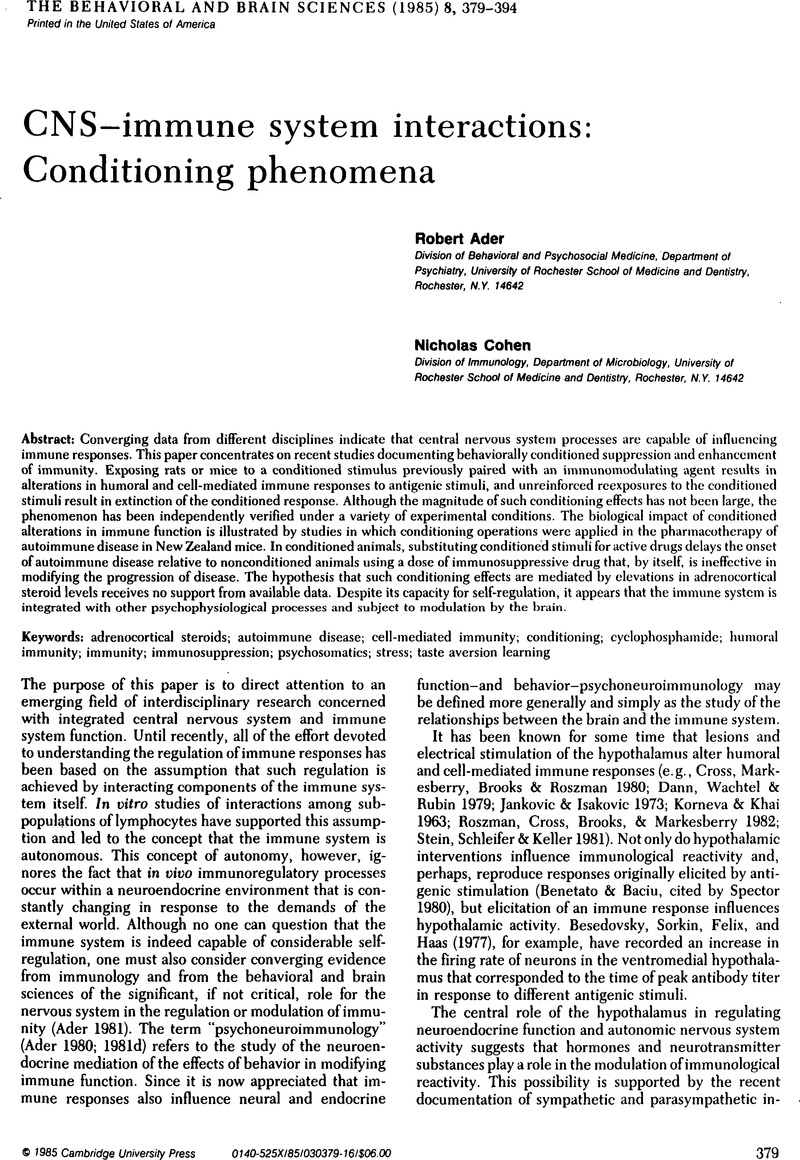Crossref Citations
This article has been cited by the following publications. This list is generated based on data provided by Crossref.
Fantino, Edmund
1989.
Response utility in classical and operant conditioning.
Behavioral and Brain Sciences,
Vol. 12,
Issue. 1,
p.
141.
Jacobs, W. J.
1989.
What is classical conditioning?.
Behavioral and Brain Sciences,
Vol. 12,
Issue. 1,
p.
146.
Samar, Vincent J.
and
Berent, Gerald P.
1989.
Classical conditioning and language: The old hegemony.
Behavioral and Brain Sciences,
Vol. 12,
Issue. 1,
p.
158.
Overmier, J. Bruce
1989.
Mis(sed)-representations.
Behavioral and Brain Sciences,
Vol. 12,
Issue. 1,
p.
156.
Lacey, Hugh
1989.
Classical conditioning beyond the laboratory.
Behavioral and Brain Sciences,
Vol. 12,
Issue. 1,
p.
152.
Riley, Anthony L.
1989.
Classical conditioning: A parsimonious analysis?.
Behavioral and Brain Sciences,
Vol. 12,
Issue. 1,
p.
157.
Krank, Marvin D.
1989.
Pavlovian conditioning: Providing a bridge between cognition and biology.
Behavioral and Brain Sciences,
Vol. 12,
Issue. 1,
p.
151.
MacQueen, Glenda
MacRae, James
and
Siegel, Shepard
1989.
Contiguity, contingency, adaptiveness, and controls.
Behavioral and Brain Sciences,
Vol. 12,
Issue. 1,
p.
154.
Furedy, John J.
1989.
Flights of teleological fancy about classical conditioning do not produce valid science or useful technology.
Behavioral and Brain Sciences,
Vol. 12,
Issue. 1,
p.
142.
Turkkan, Jaylan Sheila
1989.
Classical conditioning beyond the reflex: An uneasy rebirth.
Behavioral and Brain Sciences,
Vol. 12,
Issue. 1,
p.
161.
Klosterhalfen, Sibylle
and
Klosterhalfen, Wolfgang
1989.
Beyond respondent conditioning.
Behavioral and Brain Sciences,
Vol. 12,
Issue. 1,
p.
149.
Hollis, Karen L.
1989.
Preparatory response hypotheses: A muddle of causal and functional analyses.
Behavioral and Brain Sciences,
Vol. 12,
Issue. 1,
p.
145.
Grossberg, Stephen
1989.
Classical conditioning: The role of interdisciplinary theory.
Behavioral and Brain Sciences,
Vol. 12,
Issue. 1,
p.
144.
Moore, John W.
1989.
Cerebro-cerebellar learning loops and language skills.
Behavioral and Brain Sciences,
Vol. 12,
Issue. 1,
p.
156.
Domjan, Michael
and
Nash, Susan
1989.
Conditioning of sexual and reproductive behavior: Extending the hegemony to the propagation of species.
Behavioral and Brain Sciences,
Vol. 12,
Issue. 1,
p.
138.
Fields, Chris
1989.
Explaining classical conditioning: Phenomenological unity conceals mechanistic diversity.
Behavioral and Brain Sciences,
Vol. 12,
Issue. 1,
p.
141.
Dworkin, Barry R.
1989.
Learning and functional utility.
Behavioral and Brain Sciences,
Vol. 12,
Issue. 1,
p.
139.
Smotherman, William P.
and
Robinson, Scott R.
1989.
The conditioned response: More than a knee-jerk in the ontogeny of behavior.
Behavioral and Brain Sciences,
Vol. 12,
Issue. 1,
p.
159.
Westland, James Christopher
and
Kochen, Manfred
1989.
Classical conditioning: A manifestation of Bayesian neural learning.
Behavioral and Brain Sciences,
Vol. 12,
Issue. 1,
p.
160.
Kentridge, R. W.
1989.
Complexity at the organismic and neuronal levels.
Behavioral and Brain Sciences,
Vol. 12,
Issue. 1,
p.
147.



